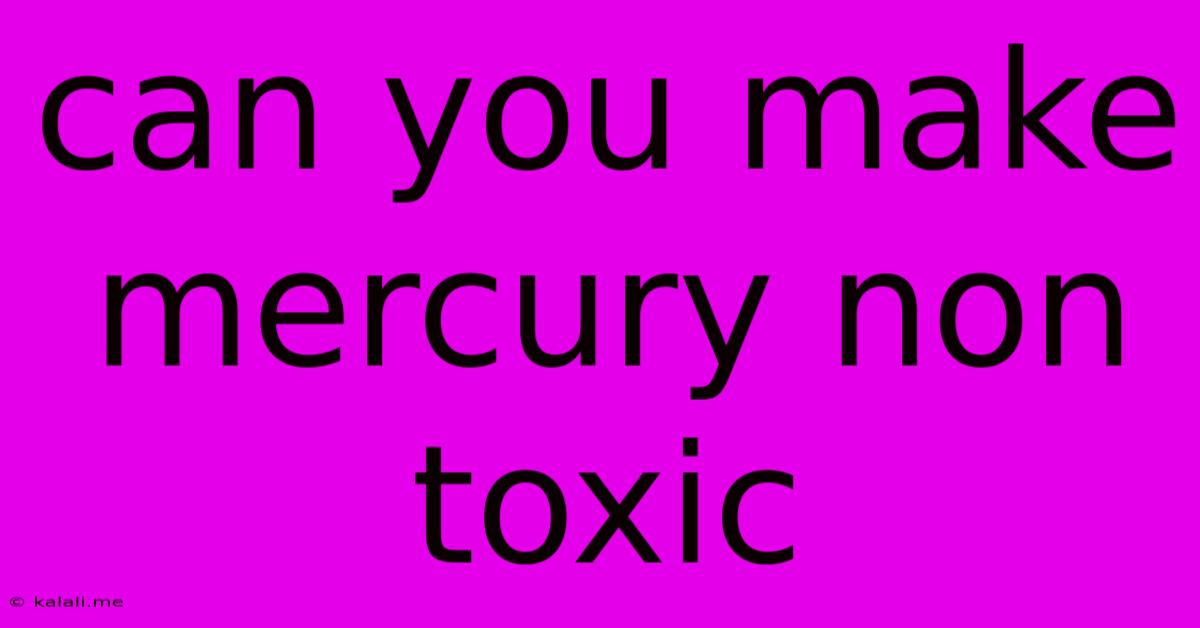Can You Make Mercury Non Toxic
Kalali
May 23, 2025 · 3 min read

Table of Contents
Can You Make Mercury Non-Toxic? The Science and Safety of Mercury
Mercury, a heavy metal with a shimmering, liquid form, is notorious for its toxicity. Exposure to even small amounts can cause serious health problems, impacting the nervous system, kidneys, and lungs. So, the question arises: can we make mercury non-toxic? The short answer is no, not in a practical, everyday sense. However, understanding the science behind mercury's toxicity helps explain why and explores potential mitigation strategies.
This article explores the nature of mercury's toxicity, the challenges in rendering it harmless, and the importance of safe handling and disposal. We'll also touch upon the ongoing research into mercury remediation.
Understanding Mercury's Toxicity
Mercury's toxicity stems from its ability to interfere with various biological processes. Different forms of mercury – elemental mercury (Hg), inorganic mercury compounds (like mercuric chloride), and organic mercury compounds (like methylmercury) – possess varying degrees of toxicity. Methylmercury, found in contaminated fish, is particularly dangerous due to its high bioavailability and tendency to accumulate in the food chain. Bioaccumulation is a key factor; mercury doesn't readily break down in the environment, leading to its concentration in organisms higher up the food chain. This is why consuming large amounts of contaminated seafood can be especially harmful.
The mechanisms behind mercury's toxicity are complex, involving its interaction with enzymes, proteins, and DNA. It can disrupt cellular processes, leading to oxidative stress, inflammation, and ultimately cell death. The severity of the effects depends on factors like the form of mercury, the route of exposure (inhalation, ingestion, skin contact), and the duration and level of exposure.
Why We Can't Simply "Make" Mercury Non-Toxic
The inherent properties of mercury make it incredibly difficult to neutralize its toxicity. Chemical reactions can change mercury's form, but often these transformations create other hazardous compounds. For instance, while some chemical treatments can immobilize mercury, preventing its leaching into the environment, they don't necessarily eliminate its inherent toxicity. The mercury remains, just in a less mobile form.
Complete detoxification, meaning the transformation of mercury into an entirely inert and harmless substance, remains a significant challenge. While researchers are exploring various advanced techniques, a readily available and cost-effective method for large-scale mercury detoxification hasn't been developed yet.
Managing Mercury: Safe Handling and Disposal
Since we can't make mercury non-toxic, the focus shifts to responsible handling and disposal. This involves:
- Proper Containment: Storing mercury in sealed, leak-proof containers is crucial to prevent spills and vapor release.
- Specialized Disposal: Mercury should never be disposed of in regular trash or down the drain. Contact your local waste management authorities for guidance on proper disposal procedures. They often have specific programs for hazardous waste, including mercury.
- Environmental Remediation: Cleaning up mercury spills and contaminated sites requires specialized techniques and expertise. These often involve physical removal of contaminated materials and the use of chemical treatments to immobilize the remaining mercury.
- Reducing Exposure: Awareness and education play a vital role in minimizing mercury exposure. Understanding the sources of mercury contamination (e.g., certain types of fish, some older thermometers) and taking precautions can significantly reduce risk.
Ongoing Research and Future Directions
While complete detoxification of mercury remains elusive, ongoing research explores innovative approaches to managing and remediating mercury contamination. These include:
- Bioremediation: Using microorganisms to break down or transform mercury into less harmful forms.
- Nanotechnology: Developing nanomaterials for efficient mercury capture and removal from water and soil.
- Advanced oxidation processes: Employing powerful oxidizing agents to transform mercury into less toxic compounds.
These advancements hold promise for future mercury management, but practical applications and widespread implementation remain a long-term goal.
In conclusion, rendering mercury completely non-toxic is currently beyond our capabilities. However, focusing on safe handling, proper disposal, and ongoing research into effective remediation strategies is crucial to minimizing the risks associated with this hazardous element. The emphasis should remain on preventing further contamination and mitigating existing mercury pollution.
Latest Posts
Latest Posts
-
What Is A Group Of Scorpions Called
May 23, 2025
-
Do You Only Adjust The Value Of Pp
May 23, 2025
-
Can I Use Fiber Board To Cover Window Opening
May 23, 2025
-
An Update Is Ready To Install Notino Ading Helper Tool
May 23, 2025
-
Fetured On The List Vs In The List
May 23, 2025
Related Post
Thank you for visiting our website which covers about Can You Make Mercury Non Toxic . We hope the information provided has been useful to you. Feel free to contact us if you have any questions or need further assistance. See you next time and don't miss to bookmark.